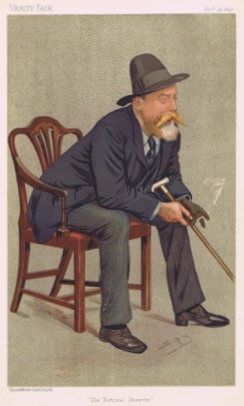Henry De Vere Stacpoole
Aka Tyler De Saix
Medical Doctor, Author, Poet, Biographer, Translator
Born April 9, 1863, Kingstown (now Dún Laoghaire), County Dublin, Ireland
Died April 12, 1951, Shanklin, Isle of Wight, England
Letter to "The Eyrie"
Aka Tyler De Saix
Medical Doctor, Author, Poet, Biographer, Translator
Born April 9, 1863, Kingstown (now Dún Laoghaire), County Dublin, Ireland
Died April 12, 1951, Shanklin, Isle of Wight, England
Henry De Vere Stacpoole was born on April 9, 1863, in Kingstown, a port city located south of Dublin. His father was William C. Stacpoole, a doctor of divinity at Trinity College and headmaster of Kingstown school. His mother was Charlotte Augusta Mountjoy Stacpoole, a native of Canada. In 1871, Stacpoole's mother took her son and three daughters to Nice in the south of France so that he might convalesce from an ailment of the lungs. He returned to Ireland to attend the boarding school at Portarlington. From there it was on to Malvern College in London, then St. George's Hospital, University College, and St. Mary's Hospital. Stacpoole completed his education and received his degree in medicine in 1891. For a short time thereafter he served as a ship's doctor. His first novel, The Intended, was published in 1894. In all, he published more than ninety novels, collections, biographies, translations, and books of verse. His number of books in fact exceeded the number of years in his very long life. Stacpoole's most well-known novel is The Blue Lagoon. Originally published in 1908, it has been adapted to film five times. Other movies based on his work include The Man Who Lost Himself (1920, 1941), Beach of Dreams (1921), and The Truth About Spring (1965). His older brother, William Henry Stacpoole (1846-1914), was also a writer and an author of genre works. Twins and doppelgängers are themes in the fiction of the two Stacpoole brothers. In addition to writing novels and other books, Henry De Vere Stacpoole contributed to Popular Magazine, Weird Tales, and The Yellow Magazine. He served as a country doctor in England for several years. In the 1920s, he relocated to the Isle of Wight, the place of his death on April 12, 1951. He had just turned eighty-eight. Henry De Vere Stacpoole's grave is at Bonchurch on the Isle of Wight.
Henry De Vere Stacpoole's Story in Weird Tales
"Dead Girl Finotte" (Jan. 1930)
Further Reading
Biographies: The Encyclopedia of Science Fiction; Guardian Books; The Literature Network; Wikipedia.
 |
| A French edition of The Blue Lagoon by Henry De Vere Stacpoole. I'm not sure whether this book was a tie-in to the movie, but that looks an awful lot like Jean Simmons . . . |
Harold Lawlor
Author
Born June 15, 1910, Ireland, or Chicago, Illinois
Died March 27, 1992, St. Petersburg, Florida
Harold Lawlor wrote twenty-nine stories for Weird Tales, yet little is known of his life, at least as far as the Internet is concerned. He was born on June 15, 1910, in Ireland (according to the Internet Speculative Fiction Database) or in Chicago (according to the Social Security Death Index). His career as an author of genre fiction began in April 1942 with "The Eternal Priestess," published in Fantastic Adventures. His first story for Weird Tales was "Specter in the Steel" from May 1943. Of note is Lawlor's story "Mayaya's Little Green Men" (Weird Tales, Nov. 1946), the first genre work to use the phrase little green men. In the early 1960s, Rapuzzi Johannis, an Italian artist and author, claimed to have encountered a little green man in the Dolomite Mountains of his home country in August 1947, the first summer of the flying saucer era. That encounter came less than a year after Lawlor's story first appeared. Lawlor had his work adapted to screen in three episodes of the television show Thriller, "The Terror in Teakwood," "The Grim Reaper," and "What Beckoning Ghost?" all from 1961. The movie Dominique (1979) also came from "What Beckoning Ghost?" Harold W. Lawlor died on March 27, 1992, in St. Petersburg, Florida, and was buried at Calvary Catholic Cemetery in Clearwater.
Harold Lawlor's Stories in Weird Tales
"Specter in the Steel" (May 1943)
"Tamara, the Georgian Queen" (July 1943)
"The Wayward Skunk" (Sept. 1944)
"Tatiana" (Jan. 1945)
"The Peripatetic Corpse" (Mar. 1945)
"The Legend of 228" (May 1945)
"The Dark Brothers" (Sept. 1945)
"The Cranberry Goblet" (Nov. 1945)
"The Diversions of Mme. Gamorra" (Jan. 1946)
"The Silver Highway" (May 1946)
"The Cinnabar Redhead" (July 1946)
"Xerxes' Hut" (Sept. 1946)
"Mayaya's Little Green Men" (Nov. 1946)
"The Terror in Teakwood" (Mar. 1947)
"The Black Madonna" (May 1947)
"The Girdle of Venus" (Sept. 1947)
"Nemesis" (May 1948)
"What Beckoning Ghost?" (July 1948)
"The Beasts That Tread the World" (Sept. 1948)
"Lover in Scarlet" (Jan. 1949)
"The Door Beyond" (May 1949)
"The Previous Incarnation" (July 1949)
"Djinn and Bitters" (May 1950)
"Unknown Lady" (Sept. 1950)
"Grotesquerie" (Nov. 1950)
"Amok!" (July 1951)
"Lovers' Meeting" (Jan. 1952)
"Which's Witch?" (July 1952)
"The Dream Merchant" (Mar. 1953)
Letter to "The Eyrie"
July 1943
 |
| Harold Lawlor's story "The Cranberry Goblet" was the cover story for Weird Tales in November 1945. The cover artist was Lee Brown Coye. |











